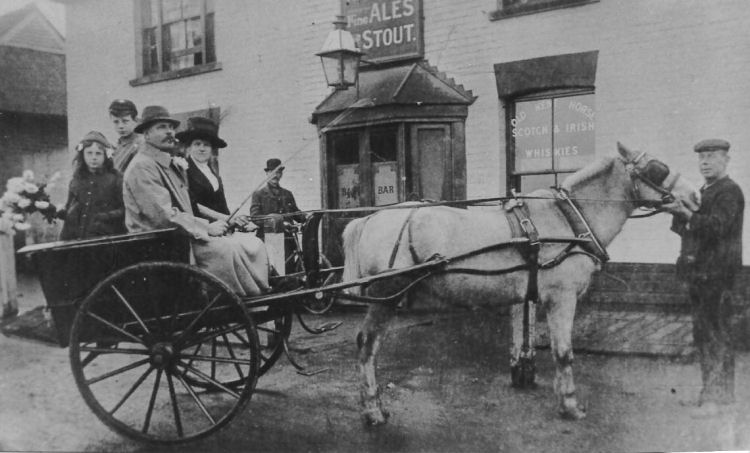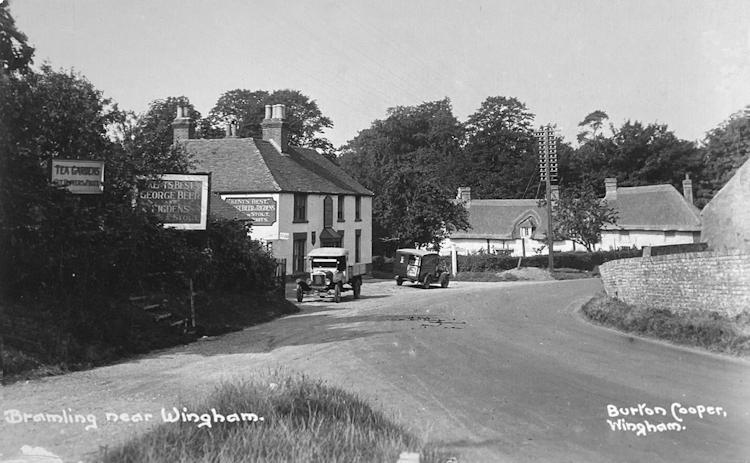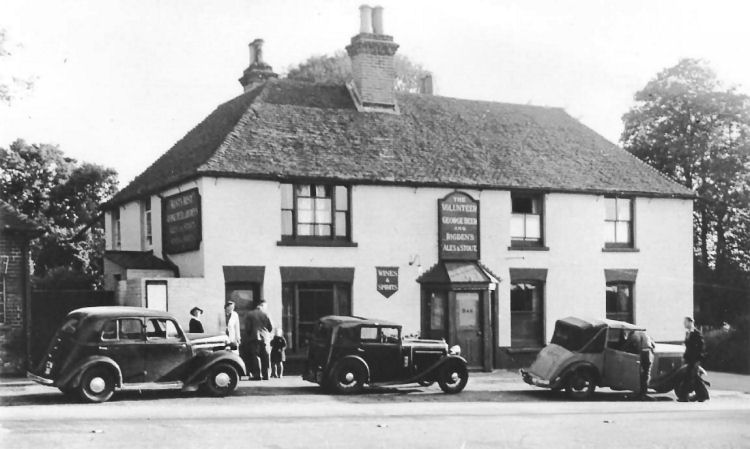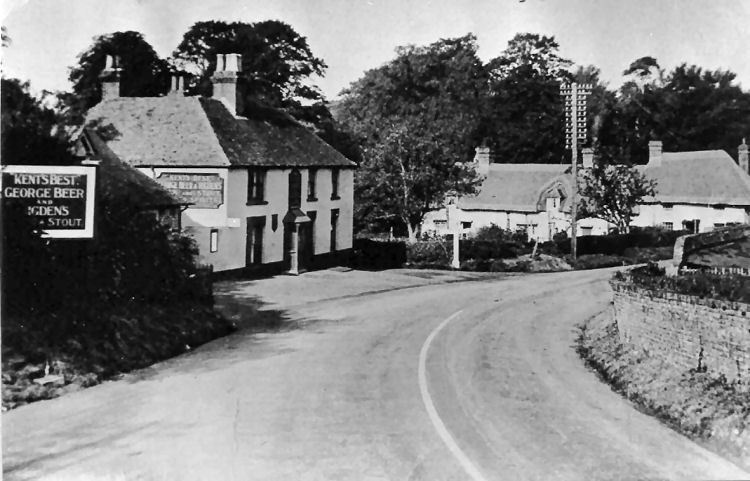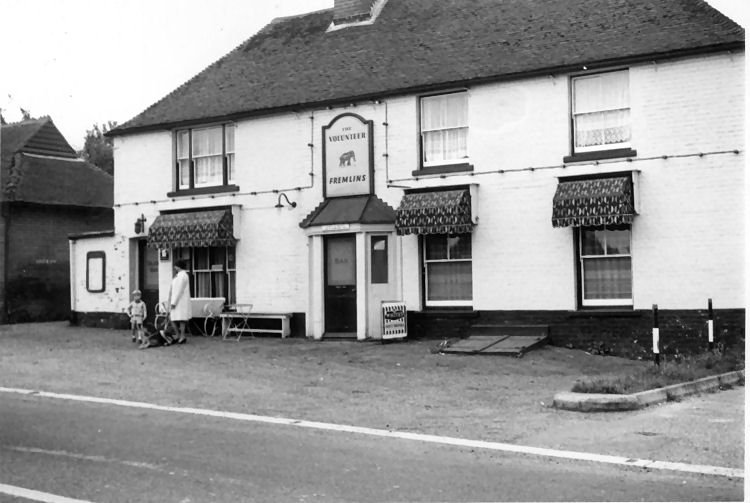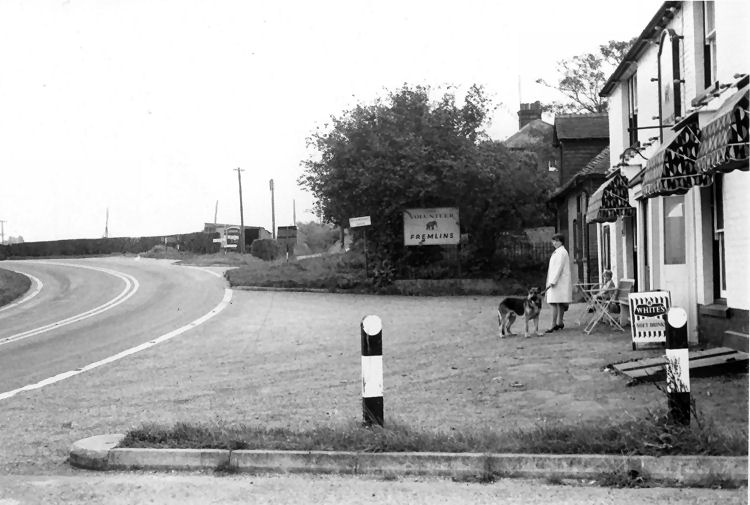|
From the Dover Express and East Kent News, 26 May 1939.
MOTOR FATALITY SEQUEL
DRIVER HEAVILY FINED.
At the Wingham Patty Sessions, at Sandwich, on Thursday, Viscount
Hawarden in the chair.
Kenneth Harry Elvidge (21), a motor engineer, of Windcheap Street,
Canterbur, was charged with driving a motor car in a manner dangerous to
the public at Brambling, on he Sandwich-Wingham road on April 21st.
Mr. Ernest White, (London), appeared for defendant, who pleaded not
guilty.
Mr. Eric Weale County Prosecuting Solicitor, said that on April 21st,
at 10.30 p.m. defendant was driving a 16-h.p. Bentley motor car from
Wingham to Canterbury and when coming round the bend by the "Volunteer"
public house it was alleged that he skidded and travelled a distance of
90 ft., struck a bank which was covered by railings, went clean through
those and down into the public house car park and there collided with
two bicycles and two cars. The car finished up in the doorway of the
public house and the door was picked up 48 feet down the road. As a
result of the accident a passenger was thrown out and received fatal
injuries (this was Sub-Lieut. Frank Denne Adams, R.N.). It was a case of
grossly dangerous driving. The road was not greasy, it was dry and
therefore the skid must have been caused by defendant' speed.
P.C. Moore (Canterbury) produced a plan of the scene of the accident.
In reply to Mr. White, witness said that he did not agree the white
curve stopped at the beginning of the bend.
Mr. White: I suggest that the mark on the road was made by the
exhaust pipe (produced) trailing on the ground? - No, I am of the
opinion it was made by the tyre.
In reply to Mr. Weale, witness said that the white line in the centre
of the road went right round the bend.
Ethelburt Horace West, Corner House, Barnsole, Staple, said that he
was riding a pedal cycle past the "Volunteer" public house and the only
other traffic he saw on the road was the car driven by defendant. It was
going very fast: it was on it's proper side of the road. He heard it
start to skid as it got opposite him and then there was a crash.
In reply to Mr. White, witness said that he could not say when the
sound of skidding might have been the exhaust pipe trailing on the
ground.
Hilda Beaney, a maid at Cliftonville School, Margate, said that she
was sitting in front of her father's car, which was parked outside the
"Volunteer" public house and was facing towards Canterbury. She saw the
lights in the windscreen of the car and then heard a noise which at
first she thought was an aeroplane. She glanced over her shoulder and
saw a car coming along the green at a terrific speed. It hit the back of
the car in which she was sitting and then crashed into the "Volunteer."
In reply to Mr. White, witness said that she was first interviewed by
the Police after the second hearing of the inquest.
Mr. White: Your car was back against the railings? - Yes.
And there are bushes behind? - Yes.
And you still say you saw the headlights of the car? - Yes.
Percival John Cordrey, 11, Cambridge Terrace, Walmer, said he was
sitting in his car in the car park outside the "Volunteer" at about
10.30 on the night in question, and he was facing towards Wingham. He
had two small side-lights on. He started to reverse and saw the lights
of a car through the back window of a stationary car in front and then
heard a crash immediately followed by a second crash as the car smashed
into the "Volunteer." No car could have been effected by the lights of
his car.
In reply to Mr. White, witness said that his lights would not shine
down the road up which the defendant was driving.
P.C. Clayton said that he arrived at the scene of the accident at
10.50 p.m. and saw four motor vehicles on the car park. Defendant's car
was partly in the public house and a car wedged to the nearside running
board of defendant's car. There was another ca on the Goodnestone end,
which was damaged on the nearside and on the Canterbury side was
Cordrey's car. One of the defendant's passengers had been thrown out and
he was dead and four people were injured. With the aid of torches
witness took measurements to show the position of the cars and the pool
of blood. The following day he went to the scene with other police
officers and made other measurements. On the Wingham side of the
"Volunteer," 7 feet from the near side of the road was a skid mark
extending for 99 feet until the bank was reached, on the Goodnestone
side of the public house. The car must have gone through the railings on
the bank and some of the railings were found in the car park. There was
a skid mark on the car park for a distance of 24 feet and from the bank
to the wall of the car park was a distance of some 15 feet. The width of
the road opposite the "Volunteer" was 31 feet and where the skid
commenced it was 18 feet wide. A white line extended the whole length of
the road and there was also a white curb-stone indicating the bend. The
front window and the porch of the public house were extensively damaged
and 48 feet further on he found bits of the porch. At 11.30 p.m.
defendant stated, "I was going towards Canterbury and I was trying to
put on a pair of glasses. The blew back onto my face. I suddenly saw a
car on my right when my lights were dipped and my main object was to get
out of the way of it. I actually thought I was on a straight road and
saw what I thought was the back of a car so I turned to my left. I
temporarily lost consciousness. The car belongs to my father I was not
going at any great speed." When told he would be reported defendant
said, "All I'm concerned with is the people in hospital."
Mr. White: "He was perfectly sober? - Yes.
The skid mark was about 2 feet or 3 feet wide? - Yes.
If it had been caused by the tyre you would have expected it to be
wider?- Not necessarily.
The skid mark you saw did not go straight up to the mark made by the
wheels of the car on the bank? - There were wheel marks more or less in
line.
In reply to Mr. Weale, witness said that in his opinion no lights in
the "Volunteer" car park could have appeared to be on the right-hand
side of the road to defendant.
This concluded the case for the prosecution.
Defendant giving evidence said that he was in his father's business
and attached to the Auxiliary Air Force, and had to go to Detling every
Thursday evening and three Sundays in the month. It was vital for him to
have a license so that he could get to Detling and also for carrying on
business. The car he was driving on the night in question was a 1925
Bentley, and when it reached a speed of 45 m.p.h. the gears whined. He
had tinted glasses which he put on before the accident occurred. He knew
the road fairly well and when he last went along it there was a hedge
and wall at that corner. His speed was just over 40 m.p.h. but under 45
m.p.h. as the gears were not whining. It was a de-controlled road. He
had two sidelights on and one headlight which was dipped. Ahead he saw
lights which he took to be the lights of a car on his right-hand side.
He suddenly saw the bend in front of him and applied his breaks. He went
onto the grass verge and he felt something - he thought it must have
been his glasses - go up in his face and he lost consciousness. He did
not think he quite put the brakes on as he only remembered taking his
foot off the accelerator and going for the brake. The skid mark could
not have been caused by him breaking.
In reply to Mr. Weale, witness said that his father pointed out the
exhaust pipe to him a fortnight after the accident, when witness came
out of hospital. When he made a statement to the police he was rather
vague about the glasses.
Mr. Weale: Would not the whine that the gears were making when the
car was going over 45 m.p.h. sound like the noise of an aeroplane which
Mrs. Beaney heard? - You would only hear the whine if you were sitting
above the gears.
The whole cause of the accident was the speed at which you were going
round the corner?- I thought I was on a straight road.
James Walton, 10, York Road, Canterbury, said that he was in the car
sitting next to the defendant. He knew there was a whining noise from
the gears if the car's speed was over 45 m.p.h. but heard no noise on
the night in question. His nose was bleeding and he did not see much of
the events leading up to the accident.
William Thomas, Bramling Cottage, Bramling, said hat he lived
practically on the scene of the accident. He was chauffeur to Col.
Friend and had 27 years driving experience. He was in the house and went
out when he heard the crash. Regarding he mark on the road the only way
that could have been caused by the wheel was if the tyre was flat and
that the mark was made by the rim. He thought when he first saw the mark
that it must have been caused by some other part of the car becoming
loose. The exhaust pipe (produced) might have caused the mark if it had
been hanging down.
Lewis B. Elvidge, motor engineer at Canterbury, and father of
defendant, said that he had been in the motor business for about 36
years. He towed the car away about midnight, the same night as the
accident, and noticed the exhaust pipe had become loose and was trailing
on the ground. He was of the definite opinion that the mark on the road
was caused by the exhaust pipe.
Mr. White, addressing the Magistrates, said that the public house was
at right angles to the road and there was nothing to indicate that it
was a public house so that might easily be taken for the lights of a car
by someone coming up the road from Wingham. As regards the prosecutions
allegations that the marks on the road were caused by the defendant
braking whilst he was speeding, he asked the Magistrates to accept the
evidence of the defence that the mark was made by the exhaust pipe. He
asked the Magistrates to dismiss the case, but reminded them that if
they decided the defendant had not been as careful as he might have been
they could reduce the charge to one of driving without due care and
attention.
After a retirement of 20 minutes, the Chairman said the Magistrates
had decided to convict.
Supt. Cash said that the defendant had two previous convictions. On
9th December, 1936, At St. Augustine's Petty Sessions, he was fined 10s.
for having no light on a motor car, and at the Canterbury City Police
Court on the 12th of this month, he was fined £3 and license endorsed
for speeding.
Defendant was fined £15 and license suspended for one year. He
was also ordered to pay two guineas towards the costs of the prosecution
and 14s. witness's costs.
Mr. White asked if the Magistrates could reconsider the question of
suspending the license bearing in mind defendant being a member of the
Auxiliary Air Force and had to get to Detling.
The Chairman: We have considered that. He must have been going very
fast and even at 40 m.p.h. that corner is not safe. I am afraid we
cannot alter our decision.
|
